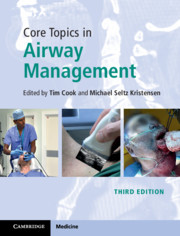58 results
Chapter 38 - Airway Management in a Respiratory Epidemic or Pandemic
- from Section 3 - Airway Management: Organisation
-
-
- Book:
- Core Topics in Airway Management
- Published online:
- 03 October 2020
- Print publication:
- 03 December 2020, pp 321-330
-
- Chapter
- Export citation
Contributors
-
- Book:
- Core Topics in Airway Management
- Published online:
- 03 October 2020
- Print publication:
- 03 December 2020, pp vii-xii
-
- Chapter
- Export citation
Foreword
-
- Book:
- Core Topics in Airway Management
- Published online:
- 03 October 2020
- Print publication:
- 03 December 2020, pp xiii-xiv
-
- Chapter
- Export citation
Section 1 - Airway Management: Background and Techniques
-
- Book:
- Core Topics in Airway Management
- Published online:
- 03 October 2020
- Print publication:
- 03 December 2020, pp 1-184
-
- Chapter
- Export citation
Chapter 13 - Supraglottic Airways
- from Section 1 - Airway Management: Background and Techniques
-
-
- Book:
- Core Topics in Airway Management
- Published online:
- 03 October 2020
- Print publication:
- 03 December 2020, pp 102-121
-
- Chapter
- Export citation
Section 2 - Airway Management: Clinical Settings and Subspecialties
-
- Book:
- Core Topics in Airway Management
- Published online:
- 03 October 2020
- Print publication:
- 03 December 2020, pp 185-292
-
- Chapter
- Export citation
Contents
-
- Book:
- Core Topics in Airway Management
- Published online:
- 03 October 2020
- Print publication:
- 03 December 2020, pp v-vi
-
- Chapter
- Export citation
Index
-
- Book:
- Core Topics in Airway Management
- Published online:
- 03 October 2020
- Print publication:
- 03 December 2020, pp 331-344
-
- Chapter
- Export citation
Section 3 - Airway Management: Organisation
-
- Book:
- Core Topics in Airway Management
- Published online:
- 03 October 2020
- Print publication:
- 03 December 2020, pp 293-330
-
- Chapter
- Export citation
Chapter 17 - Videolaryngoscopy
- from Section 1 - Airway Management: Background and Techniques
-
-
- Book:
- Core Topics in Airway Management
- Published online:
- 03 October 2020
- Print publication:
- 03 December 2020, pp 153-160
-
- Chapter
- Export citation
Chapter 3 - The Epidemiology of Airway Management Complications
- from Section 1 - Airway Management: Background and Techniques
-
-
- Book:
- Core Topics in Airway Management
- Published online:
- 03 October 2020
- Print publication:
- 03 December 2020, pp 22-37
-
- Chapter
- Export citation
Preface to the Third Edition
-
- Book:
- Core Topics in Airway Management
- Published online:
- 03 October 2020
- Print publication:
- 03 December 2020, pp xv-xvi
-
- Chapter
- Export citation
Copyright page
-
- Book:
- Core Topics in Airway Management
- Published online:
- 03 October 2020
- Print publication:
- 03 December 2020, pp iv-iv
-
- Chapter
- Export citation

Core Topics in Airway Management
-
- Published online:
- 03 October 2020
- Print publication:
- 03 December 2020
New Radiocarbon Dates Show Early Neolithic Date of Flint-Mining and Stone Quarrying in Britain
-
- Journal:
- Radiocarbon / Volume 62 / Issue 1 / February 2020
- Published online by Cambridge University Press:
- 07 August 2019, pp. 75-105
- Print publication:
- February 2020
-
- Article
- Export citation
A facilitated approach to family case conferencing for people with advanced dementia living in nursing homes: perceptions of palliative care planning coordinators and other health professionals in the IDEAL study
-
- Journal:
- International Psychogeriatrics / Volume 29 / Issue 10 / October 2017
- Published online by Cambridge University Press:
- 27 June 2017, pp. 1713-1722
-
- Article
- Export citation
Superluminous Supernovae at High Redshift
-
- Journal:
- Publications of the Astronomical Society of Australia / Volume 34 / 2017
- Published online by Cambridge University Press:
- 06 March 2017, e012
-
- Article
-
- You have access
- HTML
- Export citation
Reasons for Removal of Emergency Department–Inserted Peripheral Intravenous Cannulae in Admitted Patients: A Retrospective Medical Chart Audit in Australia
-
- Journal:
- Infection Control & Hospital Epidemiology / Volume 37 / Issue 7 / July 2016
- Published online by Cambridge University Press:
- 01 April 2016, pp. 874-876
- Print publication:
- July 2016
-
- Article
- Export citation
Concept Mapping Analysis of Social Skills Camp Experience for Children with Disabilities
-
- Journal:
- Children Australia / Volume 41 / Issue 1 / March 2016
- Published online by Cambridge University Press:
- 19 October 2015, pp. 16-28
- Print publication:
- March 2016
-
- Article
- Export citation
Notes on contributors
-
-
- Book:
- William Wordsworth in Context
- Published online:
- 05 February 2015
- Print publication:
- 12 February 2015, pp ix-xvi
-
- Chapter
- Export citation



